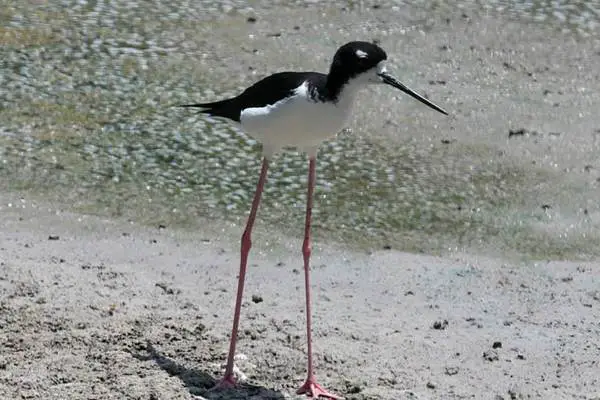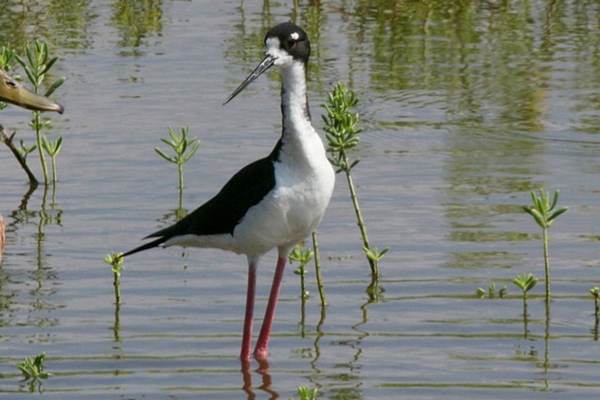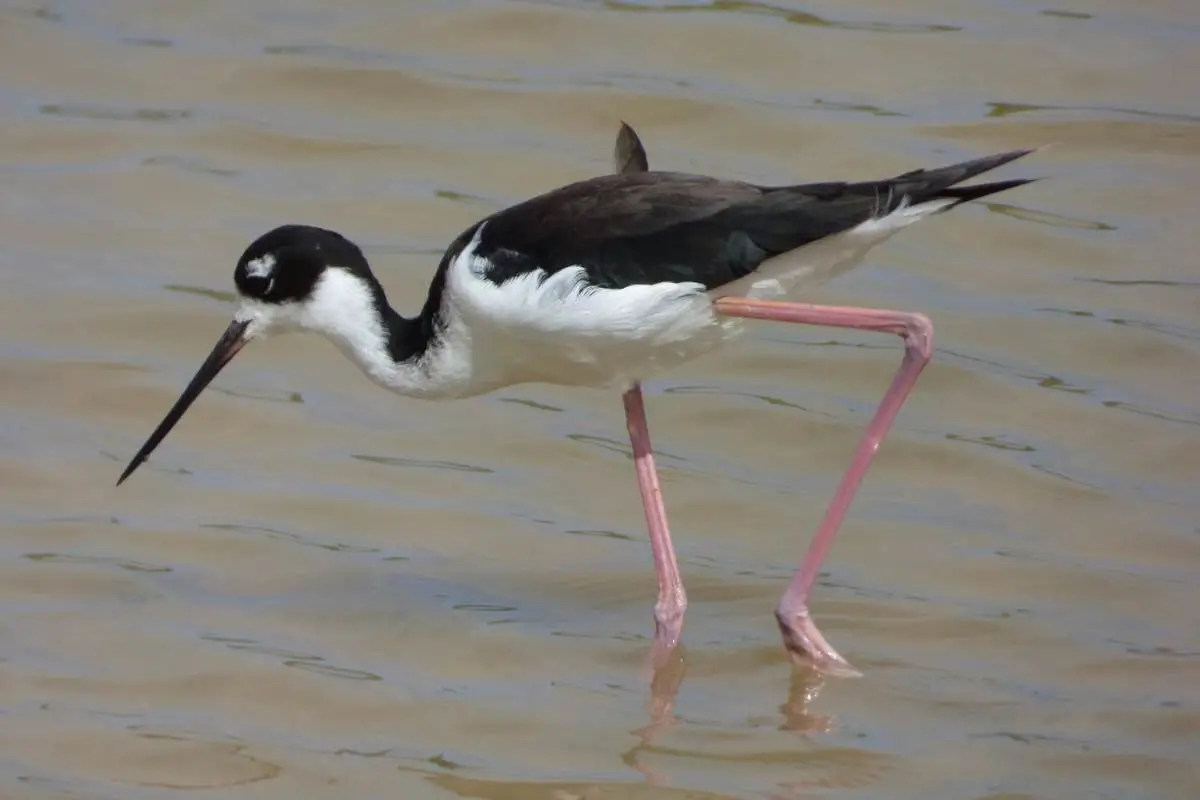Hawaiian stilt on pond | image by Forest Starr and Kim Starr via Flickr | CC BY 2.0
Common Name: Hawaiian Stilt
Scientific Name: Himantopus mexicanus knudseni| Size | Diet | Range in Hawaii | Status in Hawaii |
|---|---|---|---|
| 16 in. | worms, mollusks, insects, and small fishes | Hawaii (the Big island) | Endangered |
There are only six species of stilts found worldwide, with only one of them found on the Hawaiian islands. Hawaiian stilts are a subspecies of black-necked stilts that you can find along the shores of Hawaii.
These species, known for their long legs and bills, have some unusual ways of surviving in the wild. Let’s learn about some of the facts about Hawaiian stilts.
Hawaiin stilt

Scientific Name: Himantopus mexicanus knudseni
Appearance
The Hawaiian stilt is a large bird that measures up to 16 inches tall. Both sexes are black and white, with the females having a slight brown color on their backs. You can also tell the difference between the sexes by their voices, as females have a lower voice than males.
This unique bird has long legs that are pink in color, as well as a long tail and bill. Their chicks are brown with black speckles on the upper side and white on the underside, allowing them to blend in with their surroundings.
Diet
The Hawaiian stilt is a rare bird that has evolved to survive in Hawaii’s marshlands. It has long legs and a long bill that it uses to search for insects and other prey in the mud.
The Hawaiian stilt is a wading bird, which means it spends its days hunting for food by walking in shallow water. They also eat small fish, mollusks, crustaceans, and dragonfly larvae.
Behavioral traits
Hawaiian stilts usually live in pairs or small groups. They’re monogamous, meaning these birds only have one mate at a time. This can be observed when one bird flies away from its partner, only to return after a short time.
The birds are also very territorial, defending their territory from other stilts or birds that come too close. To further frighten the predators off, they’ll even dive bomb at them or display a broken wing to entice them away from their nests.
Hawaiian stilts are also known for their loud, sharp cry. Their calls sound like a continuous bicbicbic. To fly, they extend their long legs behind them and flap their large wings.
Breeding
The breeding season for this species lasts from March to August. They’ll build their nests on freshwater mudflats or shallow ponds with sparse vegetation.
The adults will move between the nesting and feeding areas during this season. During this time, they’re also very territorial in order to protect their eggs.
Every season, females lay 3 to 4 eggs, with both male and female incubating the egg for 24 days. Their chicks are also precocial, which means that they can join their parents in foraging for food as soon as they hatch.
They’ll also spend several months with their family group until the next breeding season.
Habitat

The foraging habitat for this species is different from its nesting habitat.
Hawaiian stilts are typically found in ephemeral freshwater, saltwater, and brackish waters in search of food that lives in shallow water. However, they can also be found on mudflats, wet grassy areas, and freshwater ponds during the breeding season.
Native Range
The species is found on all of the major islands except Ka’ho’olawe, with O’ahu having the largest population. Here’s where you can commonly see these birds in Hawaii:
- In O’ahu: north and windward coast at Kahuku Point on James Campbell National Wildlife Refuge, oyster ponds at Kahuku Point, aquaculture ponds at Amorient, Roland Pond, and Nuupia Ponds in Kaneohe. There are smaller populations at Pearl Harbor and along the leeward coast.
- In Kaua’i: large river valleys like Hanalei, Wailua, and Lumahai, as well as reservoirs and sugarcane effluent ponds in Lihue and Waimea.
- In Maui: Kanaha and Kealia coastal wetlands
- In Molokai: wetlands and playa lakes on the south coast
- In Hawaii: Kawaihai Harbor south to Kailua
Conservation Status
The International Union for Conservation of Nature (IUCN) and the US Endangered Species Act both list the Hawaiian stilt as an endangered species. This means only about 2,000 adult individuals remain in the wild.
One of the reasons for their decline is the introduction of non-native animals into Hawaii. This resulted in an increase in predators such as mongooses, dogs, cats, and rats in the area.
Interesting Facts
1. Their long legs are pink in color
Hawaiian stilts have long pink legs used to wade in shallow water. Their slender bodies are also well adapted to the tropical climate of the Hawaiian coast.
2. Hawaiian stilts are shorebirds
These stilts are shorebirds that inhabit freshwater and saltwater habitats, such as beaches, marshes, mud flats, and other coastal regions.
3. They’re also called Aeo
Because of their tall structure, Hawaiian stilts are also known as Aeo, meaning “one standing tall.” These birds have long legs and necks, giving them the appearance of walking on stilts.
4. Young chicks dive into the water
Instead of flying away from danger like adult Hawaiian stilts, young pre-fledged chicks often dive into water if something else nearby threatens them.
5. Both sexes take turns incubating day or night
Both males and females of this species are observed to incubate their eggs day and night. During hot seasons, the adults will soak their bellies in water before sitting on the eggs to cool them rather than warm them. This enables them to maintain the humidity of their nest despite the hot weather.
Frequently Asked Questions
Why is the Hawaiian stilt endangered?
These endangered bird species’ numbers have been declining for years, and the main threats to their survival are habitat loss and predation by introduced mammals like rats and mongooses.
Is a Hawaiian stilt a bird?
The Hawaiian stilt is a bird species in the Recurvirostridae family, which includes wader birds with long legs used for walking in shallow water.




